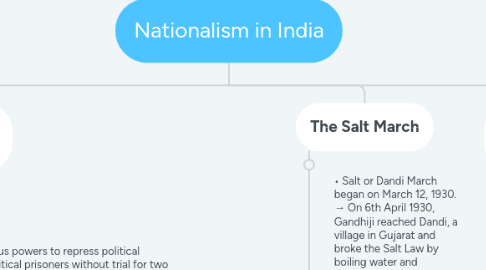
1. The First World War, Khilafat and Non-Cooperation
1.1. The Rowlatt Act (1919)
1.1.1. This act gave the government enormous powers to repress political activities and allowed detention of political prisoners without trial for two years.
1.1.2. Jallianwala Bagh massacre
1.1.2.1. • On 13th April 1919, a huge crowd gathered in Jallianwalla Bagh. • Dyer blocked the exit points, and opened fire on the crowd.
1.2. Khilafat Movement
1.2.1. • Khilafat Movement was led by two brothers Shaukat Ali and Muhammad Ali. • Khilafat Committee was formed in Bombay in March 1919 to defend the Khalifa’s temporal powers. • At the Congress session at Nagpur in December 1920, the Non-Cooperation programme was adopted.
2. The Salt March
2.1. • Salt or Dandi March began on March 12, 1930. → On 6th April 1930, Gandhiji reached Dandi, a village in Gujarat and broke the Salt Law by boiling water and manufacturing salt. → Thus, it began the Civil Disobedience Movement. • The British Government followed a policy of brutal repression. • British government arrested all the leaders including Gandhiji and Nehru. • Mahatma Gandhi called off the movement.
3. Differing strands within the movement
3.1. The Movement in the Towns
3.1.1. • It started with middle class participation in cities. • Students, teachers, lawyers gave up studies, jobs, legal practices and joined movements. • Council elections were boycotted. • Foreign goods were boycotted. • Liquor shops were picketed.
3.2. Movement in the countryside
3.2.1. Peasants and tribals took over the struggle which turned violent gradually.

